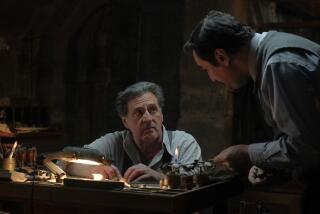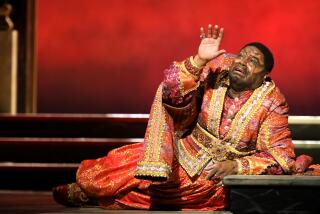Skirball exhibit looks at German film artists in U.S. during Nazi regime
A Los Angeles County Museum of Art show on post-World War I German cinema opened last month looking at the innovative feature film directors, producers, writers, costume designers and cinematographers who created influential 1920s classics such as “Nosferatu” and “Metropolis.”
Now an exhibition opening Thursday at the Skirball Cultural Center examines what happened to those artists after Adolf Hitler and the Nazi Party came to power. “Light & Noir: Exiles and Emigres in Hollywood, 1933-1950,” which continues through March 1, is co-presented by the Academy of Motion Picture Arts and Sciences.
“It’s a very rare opportunity for people in the city to see two exhibitions that tell a multi-decade, several-generations story in this kind of way,” said Ellen Harrington, director of exhibitions and collections at the Academy Museum of Motion Pictures.
Added Robert Kirschner, director of the Skirball: “I think this particular chapter of cinema and American history is familiar to some people, but I think the Jewish dimension of it may not be as familiar.”
Among the emigres featured in the exhibition are directors Ernst Lubitsch, Fritz Lang and Billy Wilder, composers Erich Wolfgang Korngold and Franz Waxman, and writer Salka Viertel.
Divided into eight sections, the exhibition’s 370 items include footage, drawings, props, costumes, posters, photographs and memorabilia that illustrate how these emigres changed Hollywood by bringing their artistic sensibilities to such genres as comedy, the exile film, the anti-Nazi film and especially film noir, which came into being in the 1940s.
“You see the German Expressionist influence in film noirs through the stark angles, the lighting methods,” curator Doris Berger said. “There are so many parallels to what they did before, except for the stories are very American and, of course, the surroundings are Los Angeles or New York.”
The exhibition, Berger said, casts “Casablanca” in a different light. The 1942 World War II romantic drama about refugees in Morocco attempting to get exit visas is the ultimate exile film. The cast features emigre actors including Paul Henreid, Peter Lorre, Conrad Veidt and Helmut Dantine. The film’s Hungarian-born director, Oscar winner Michael Curtiz, came to Hollywood in the 1920s.
“It would look and sound so different if not for all the exiles and emigres that were cast in the film and the crew,” Berger said.
The Skirball exhibition has items from “Casablanca,” including costumes worn by Ingrid Bergman and Henreid, film clips, props from Rick’s cafe, lobby cards and reviews that were published when the film was released.
Even before 1933, the film industry had “always been a home for immigrants and people who were establishing themselves in the United States,” Harrington said.
Studio moguls including Universal’s Carl Laemmle, MGM’s Louis B. Mayer and Paramount’s Adolph Zukor all hailed from Europe. “Light & Noir” explores how three key figures — Lubitsch, Laemmle and talent agent Paul Kohner — helped Jewish colleagues, family and friends out of Germany.
Laemmle, who died in 1939, wanted to save his hometown of Laupheim, said one of his descendants, Rosemary Hilb.
He wrote affidavits for “pretty much anybody who asked him,” Hilb said. He put up money to assure the U.S. government that these people wouldn’t be a burden.
Kohner’s office on Sunset Boulevard was the home base for the European Film Fund, an organization founded in 1938 to support arriving exiles and emigres.
“He would go to the studio heads and get them to commit to hire mostly writers and directors, so they would have guarantee of employment,” said Kohner’s son, Pancho Kohner. “Eventually there were 1,500 German Jewish refugees working for the American studios.”
The Skirball has two related exhibitions: “The Noir Effect,” which examines how the film noir genre has affected popular culture, and “Cafe Vienne,” an installation by artist Isa Rosenberger that shines the spotlight on the recently rediscovered work of Austrian American Jewish writer Gina Kaus.
Lectures, seminars, courses and salons will complement “Light & Noir.” November through February, the Skirball’s free Classic Films series will feature work by emigres.
Twitter: @mymackie
----------------------------
‘Light & Noir: Exiles and Emigres in Hollywood, 1933-1950’
Where: Skirball Cultural Center, 2701 N. Sepulveda Blvd., Los Angeles
When: Noon-5 p.m. Tuesday-Friday, 10 a.m.-5 p.m. Saturday-Sunday, through March 1
Admission: $5-$10; free on Thursdays
Info: (310) 440-4500, https://www.skirball.org
More to Read
The biggest entertainment stories
Get our big stories about Hollywood, film, television, music, arts, culture and more right in your inbox as soon as they publish.
You may occasionally receive promotional content from the Los Angeles Times.







